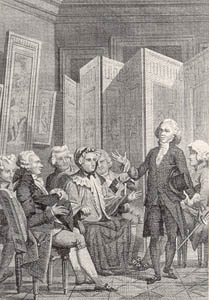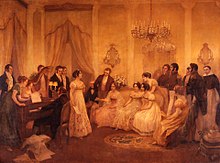沙龍 (聚會)

沙龍是由一個主人邀請其他客人參加,增加他們彼此交流的機會、愉悅自身及提升修養的聚會。沙龍最早出現於16世紀的意大利,在17至18世紀的法國中亦極為流行,直到現代仍然存在。
起源
[編輯]沙龍(salon)一詞最早出現於1664年的法國(來自意大利語salone,這個意大利詞則來自sala,即意大利豪宅中的待客廳)。在這之前的文藝聚會通常也是以所用的房間來命名,例如內閣(cabinet)、陋室(réduit)和小巷(ruelle)等。[1] 在十七世紀末,這些聚會一般會在臥室中舉行(被看做是一種私人會客廳),[2]通常情況是一位女士斜倚在床上,她的女友人們圍坐在四周的椅子上。不過像法王路易十四的petit lever中,客人全部都站着。小巷(ruelle)指床和墻之間的空間,這個詞一般來形容「矯揉造作的女子」的集會,這種集會出現在十七世紀上半葉受過教育的女子中。法國第一個著名沙龍是羅浮宮近處的朗布依埃府,其女主人朗布依埃侯爵夫人(1588-1665)從1607年開始一直舉辦沙龍直到去世。[3][4]沙龍的很多規則也是由她一手製定的。
歷史
[編輯]沙龍的歷史十分複雜,因為這要涉及女權主義、馬克思主義及各種文化、社會歷史。從不同的角度可能會看到完全不同的景象,因此對於沙龍與法國歷史和啓蒙運動究竟有多大關係有很多見解。主流歷史編纂學觀點一般集中在沙龍與公共領域(諸如女性地位)的關係上。
時代劃分
[編輯]沙龍的歷史劃分要看究竟採用哪種歷史編纂學觀點。一般意見是從十六世紀早期到十八世紀末為一個主要時期。德娜·古德曼認為其結束在法國大革命爆發時。[5]史蒂文·凱爾的觀點較為獨特,他認為這段時期至少可以推遲到1848年革命之前。[6]
內容和形式
[編輯]當時的文獻指出沙龍的主導理念是理想主義式的禮貌、優雅和誠實,但很可能實際情況並非如此。[7][8]德娜·古德曼宣稱相對作為一個「禮儀學校」(schools of civilité)來說,沙龍更是一個哲學團體,因此才推動了啓蒙運動的發展。[9]禮儀的重要性只是被放在第二位。[10]

沙龍的鼎盛年代被稱作「談話時代」(age of conversation)。[11]沙龍中談論的主題分為談起來「禮貌」或「不禮貌」兩種,沙龍的主人也被認為需要擁有緩和氣氛的能力,不過所謂「禮貌」卻沒什麼正式定義。馬塞爾·普魯斯特認為政治是一定要避開的話題。[12]但也有小部份人認為除了政府別的什麽都不應該談及。[13]
公共領域
[編輯]尤爾根·哈貝馬斯的《公共領域的結構轉型》(1962年出版)是研究沙龍與公共領域的重要著作,該書的觀點是沙龍在歷史上佔有不可忽視的地位。[14]他在定義「公共領域」時也把沙龍當做一個重要元素。[15][16]
在德娜·古德曼的《文學界》(The Republic of Letters)中,作者宣稱「公共領域就是由沙龍、新聞界和其他社交組織構成的」。[17]該著作也進一步強調了沙龍在法國歷史和啓蒙運動中的重要性,這個觀點自從1994年《文學界》出版以來就一直佔據主流地位。[18]不過也有人認為古德曼的著作「很顯然只是爲了支持(哈貝馬斯的)論文」,而不是去驗證它。[19]
相應的反對觀點來自諾博特·伊里亞思,他在《風俗史》(The History of Manners)一書中認為沙龍的重要元素——禮貌、優雅和誠實,「都是些同義詞,不論廣義狹義,不過是一些人為自己的行為選定的標準」。[20]瓊·蘭德斯(Joan Landes)也說「在某種程度上,沙龍只是制度化的宮廷的衍生物」,而不是公共領域的一部份。[21][22]其他人,例如史蒂文·凱爾宣稱私人或公共領域的概念都與沙龍有重疊。[23][24]
女性和沙龍
[編輯]沙龍和女性的關係也受到了歷史學家的關注。[25]十九和二十世紀的很多著作一般都只談到沙龍和醜聞及「小陰謀」(petty intrigues)的關係。[26]其他的一些則涉及到了沙龍中的女性的積極影響。[27]不過也因為沙龍中女性過多使得其研究進展困難——當時的大多數重要人物都是男性。[28]
一些歷史學家試圖把目光放在單個的女性身上,不過直到1970年,這些歷史學家的著作大多都是關於這些沙龍主人的個人故事。[29]在二十世紀末,隨着女權主義研究的進步,關於沙龍主人們的社會重要性的研究才逐漸多起來。[30]關於啓蒙運動的一般性著作例如,《啓蒙運動在法國》(France in the Enlightenment)傾向於認為女性的統治地位只局限於沙龍內部。[31]不過古德曼卻不這麼認為。[32] 她也曾說:「沙龍主人不是想擠到上流社會里,這些聰明的、受過教育的女子是通過吸收接納文學界的價值觀,並按自己的社會知識和教育需要將其用於塑造沙龍」。[33][34]
在吸引文人藝術家這一點上,沙龍不同於宮廷的是,它們並不用贊助來作為誘餌。另一個區別是其社會等級不太明顯。[35]在十七十八世紀,「沙龍鼓勵異性間及貴族和布爾喬亞間的社交」。[36] 因此沙龍被認為促進了社會壁壘的消失。在十八世紀,沙龍進入了啓蒙運動的陣營。[37]
沙龍主人
[編輯]沙龍主人一般都是些強勢的女性,她們是沙龍的核心,有權挑選客人、制定規則和沙龍主題。在沙龍中她們能夠得到自己想要的知識,並交換意見、給出評價,因此沙龍也被看做是這些女子對自己的繼續教育。[38]十七世紀最著名的沙龍有1607年在朗布依埃府由其女主人朗布依埃侯爵夫人舉辦的沙龍,以及1652年史居里女勳爵舉辦的沙龍。
十八世紀著名的沙龍主人有:
法國以外的沙龍
[編輯]


沙龍一度風靡歐洲,在十八到十九世紀,很多仿照巴黎式沙龍的沙龍出現在了歐洲各地,甚至包括一些新世界國家。
在十八世紀的英格蘭,最著名沙龍主人是伊利沙伯·蒙塔古,「藍襪子」(Bluestocking)一詞就誕生自她的沙龍中,也是她本人成立了藍襪社。十九世紀為避1848年革命而躲到倫敦的俄羅斯梅里男爵夫人(Baroness Méry von Bruiningk)的沙龍也很有名。1860年代,女權主義者克萊門蒂亞·泰勒在倫敦也舉辦過激進的沙龍,參加她沙龍的人有[39]露意莎·奧爾柯特、[40]芭芭拉·博迪肯、莉蒂亞·貝克爾和伊利沙伯·布萊克威爾[41]。
在德國,沙龍主人包括一些猶太女性例如海利薇·赫茨和拉赫爾·瓦爾哈根,西班牙有第十三代阿爾巴女公爵(18世紀),希臘則有Alexandra Mavrokordatou(17世紀)。
16世紀的意大利藝妓圖利婭·達拉戈納舉辦過早期沙龍,其他人還有退位後的克里斯蒂娜女王和瑪麗·曼奇尼。19世紀時沙龍在意大利還再次興盛過一段時期,並在意大利歷史中佔據着一定的地位。當時爲了逃避政府審查,很多社會評論都是在沙龍中做出的。在這之後新聞界就取代了沙龍的位置。[42]
在伊比利亞半島或拉丁美洲,圖特利亞(tertulia)是一種類似沙龍的文藝聚會。這個詞最初來自西班牙語,20世紀的圖特利亞多舉辦在公眾場合,與會者會互相分享詩歌等藝術作品。[43]阿根廷的瑪利基塔·桑切斯是布宜諾斯艾利斯著名的沙龍主人。[44]她熱心於革命,因此其圖特利亞聚集了當時幾乎所有的著名革命人物。1813年5月14日,阿根廷國歌祖國進行曲的首次歌唱就是在她的家中。[45]
在十七世紀的波蘭,斯尼亞夫斯卡女公爵曾舉辦過沙龍,十八世紀就更加普遍了,最著名的為十八世紀末的大公斯坦尼斯瓦夫二世的週四晚餐。
在斯堪的納維亞,沙龍由索菲亞·伊利沙伯·布倫納在十七世紀引入瑞典。十八世紀的沙龍主人有海德薇格·夏洛塔·諾登弗呂希特和安娜·瑪麗·倫格倫。十九世紀也有馬拉·西爾弗斯托爾佩。在丹麥,十八世紀末的克利斯蒂安·索菲·霍爾施泰因和夏洛特·西梅爾曼對該國政治也產生了一定影響。
參見
[編輯]參考文獻
[編輯]- ^ (法文) Dictionaire des lettres françaises: le XVIIe siècle, revised edition by Patrick Dandrey, ed. Fayard, Paris, 1996, p. 1149. ISBN 2-253-05664-2
- ^ Aronson, Nicole, Madame de Rambouillet ou la magicienne de la Chambre bleue, Fayard, Paris, 1988.
- ^ Kale,Steven.French Salons : High Society and Political Sociability from the Old Regime to the revolution of 1848. Baltimore : The Johns Hopkins University Press, 2004. p.2
- ^ Lenotre, G. Le Château de Rambouillet, six siècles d'Histoire, Calmann-Lévy, Paris, 1930. New publication, Denoël, Paris, 1984, chapter: Les précieuses, pp. 20-21
- ^ Dena Goodman, The Republic of Letters: A Cultural History of the French Enlightenment (Ithaca: Cornell University Press, 1994), p. 280.
- ^ Steven Kale, French Salons: High Society and Political Sociability from the Old Regime to the Revolution of 1848 (Baltimore: Johns Hopkins University Press, 2006) p. 9
- ^ Sisley Huddleston, Bohemian, Literary and Social Life in Paris: Salons, Cafes, Studios (London: George G. Harrap, 1928)
- ^ Steven Kale, French Salons, p. 5.
- ^ Dena Goodman, 'Enlightenment Salons: The Convergence of Female and Philosophic Ambitions' Eighteenth-Century Studies, Vol. 22, No. 3, Special Issue: The French Revolution in Culture (Spring, 1989), pp. 330
- ^ Ibid., pp. 329-331
- ^ Benedetta Craveri, The Age of Conversation (New York: New York Review Books, 2005)
- ^ Kale, French Salons, p. 5.
- ^ Ibid., p. 5.
- ^ Jürgen Habermas (trans. Thomas Burger), The Structural Transformation of the Public Sphere: An Inquiry into a Category of Bourgeois Society (Camb., Mass.: MIT Press, 1989).
- ^ Ibid., p. 30.
- ^ Joan B. Landes, Women and the Public Sphere in the Age of the French Revolution (Ithaca: Cornell University Press, 1988); Goodman, The Republic of Letters; Erica Harth, Cartesian Women: Versions and Subversions of Rational Discourse in the Old Regime (Ithaca: Cornell University Press, 1992).
- ^ Dena Goodman, The Republic of Letters: a Cultural History of the French Enlightenment (Ithaca: Cornell University Press, 1994), p. 14.
- ^ Kale, French Salons, p. 238 n. 5.
- ^ Jolanta T. Pekacz, Conservative Tradition In Pre-Revolutionary France: Parisian Salon Women (New York: Peter Lang, 1999) p. 3.
- ^ Norbert Elias (Trans. Edmund Jephcott), The Civilising Process: The History of Manners, Vol. 1 (Oxford: Basil Blackwell, 1978), pp. 39-40.
- ^ Landes, Women and the Public Sphere in the Age of the French Revolution, pp. 23-5.
- ^ Landes, Women and the Public Sphere in the Age of the French Revolution, p. 23
- ^ Kale, French Salons, p. 12.
- ^ Antoine Lilti, 『Sociabilité et mondanité: Les hommes de lettres dans les salons parisiens au XVIIIe siècle’ French Historical Studies, Vol. 28, No. 3 (Summer 2005), p. 417.
- ^ Jolanta T. Pekacz, Conservative Tradition In Pre-Revolutionary France: Parisian Salon Women, p. 1.
- ^ S. G. Tallentyre, Women of the Salons (New York: G. P. Putnam’s Sons, 1926) and Julia Kavanagh, Women in France during the Enlightenment Century, 2 Vols (New York: G. P. Putnam’s Sons, 1893).
- ^ Edmond et Jules Goncourt, La femme au dix-huitème siècle (Paris: Firmin Didot, 1862) and Paul Deschanel, Figures des femmes (Paris: Calmann-Lévy, 1900).
- ^ Pekacz, Conservative Tradition In Pre-Revolutionary France, p. 2.
- ^ Anny Latour (Trans. A. A. Dent), Uncrowned Queens: Reines Sans Couronne (London: J. M. Dent, 1970)
- ^ Carolyn C. Lougee, Women, Salons and Social Stratification in Seventeenth Century France, pp. 3-7.
- ^ Daniel Roche (Trans Arthur Goldhammr), France in the Enlightenment, (Cambridge, Mass.: HUP, 1998), pp. 443-8.
- ^ Goodman, The Republic of Letters, pp. 1-11.
- ^ Ibid., p. 76.
- ^ Pekacz, Conservative Tradition In Pre-Revolutionary France, p. 6; Lilti, 『Sociabilité et mondanité, p. 2.
- ^ Goodman,Dena.Enlightenment salons: The Convergence of Female and Philosophic Ambitions. Eighteenth-Century Studies, Vol. 22. 3, Special issue : The French Revolution in Culture. ( Spring, 1989),p 338
- ^ Kale,Steven.French Salons : High Society and Political Sociability from the Old Regime to the revolution of 1848. Baltimore : The Johns Hopkins University Press,2004. p.2
- ^ Goodman,Dena.Enlightenment salons: The Convergence of Female and Philosophic Ambitions. Eighteenth-Century Studies, Vol. 22. 3, Special issue : The French Revolution in Culture. ( Spring, 1989),p.331
- ^ Bodek, Evelyn Gordon.Salonnières and the Bluestockings : Educated Obsolescence and Germinating feminism, Feminist Studies, Vol. 3 No. 3/4 ( spring-summer, 1976), p. 186
- ^ Moncure Daniel Conway. Autobiography Memories and Experiences of Moncure Daniel Conway. Volume 2. Elibron.com. June 2001: 14– [1 December 2012]. ISBN 978-1-4021-6692-1. (原始內容存檔於2014-06-27).
- ^ TayODNB.
- ^ MunODNB.
- ^ Romani, Gabriela. A room with a view: interpreting the Ottocento through the literary salon.. [16 April 2012]. (原始內容存檔於2013-05-24).
- ^ El Madrid de 1900, espacios populares de Cultura y Ocio (頁面存檔備份,存於互聯網檔案館) [Madrid in 1900, popular spaces for culture and leisure]; Tertulia Andaluza (頁面存檔備份,存於互聯網檔案館) ("Tertulia Andaluza")
- ^ Soledad Vallejos. Recuperando a Mariquita. Perfil. July 16, 2004 [February 10, 2013]. (原始內容存檔於2014-05-14).
- ^ Galasso, Norberto. Seamos libres y lo demás no importa nada [Let us be free and nothing else matters]. Buenos Aires: Colihue. 2000: 102. ISBN 978-950-581-779-5 (西班牙語).
參考書目
[編輯]- Craveri, Benedetta, The Age of Conversation (New York: New York Review Books, 2005)
- Davetian, Benet, Civility: A Cultural History (University of Toronto Press, 2009)
- Elias, Norbert, (Trans. Edmund Jephcott), The Civilising Process: The History of Manners, Vol. 1 (Oxford: Basil Blackwell, 1978)
- Goodman, Dena, The Republic of Letters: A Cultural History of the French Enlightenment (Ithaca: Cornell University Press, 1994)
- Goodman,Dena, Enlightenment Salons: The Convergence of Female and Philosophic Ambitions, Eighteenth-Century Studies, Vol. 22, No. 3, Special Issue: The French Revolution in Culture (Spring, 1989), pp. 329–350
- Kale, Steven, French Salons: High Society and Political Sociability from the Old Regime to the Revolution of 1848 (Baltimore: Johns Hopkins University Press, 2006)
- Habermas, Jürgen, (trans. Thomas Burger), The Structural Transformation of the Public Sphere: An Inquiry into a Category of Bourgeois Society (Camb., Mass.: MIT Press, 1989)
- Harth, Erica, Cartesian Women: Versions and Subversions of Rational Discourse in the Old Regime (Ithaca: Cornell University Press, 1992).
- Huddleston, Sisley, Bohemian, Literary and Social Life in Paris: Salons, Cafes, Studios (London: George G. Harrap, 1928)
- Kavanagh, Julia, Women in France during the Enlightenment Century, 2 Vols (New York: G. P. Putnam’s Sons, 1893)
- Landes, Joan B., Women and the Public Sphere in the Age of the French Revolution (Ithaca: Cornell University Press, 1988);
- Latour, Anny (Trans. A. A. Dent), Uncrowned Queens: Reines Sans Couronne (London: J. M. Dent, 1970)
- Lougee, Carolyn C., Le Paradis des Femmes: Women, Salons and Social Stratification in Seventeenth Century France (Princeton: Princeton University Press, 1976)
- Lilti, Antoine, Sociabilité et mondanité: Les hommes de lettres dans les salons parisiens au XVIIIe siècle, French Historical Studies, Vol. 28, No. 3 (Summer 2005), p. 415-445
- Pekacz, Jolanta T., Conservative Tradition In Pre-Revolutionary France: Parisian Salon Women (New York: Peter Lang, 1999)
- Roche, Daniel, (Trans Arthur Goldhammr), France in the Enlightenment, (Cambridge, Mass.: HUP, 1998)
- Tallentyre, S. G., Women of the Salons (New York: G. P. Putnam’s Sons, 1926)
- Von der Heyden-Rynsch, Verena, Europaeische Salons. Hoehepunkte einer versunken weiblichen Kultur (Düsseldorf: Artemis & Winkler, 1997)
擴展閱讀
[編輯]- Beasley, Faith E. Salons, History, and the Creation of Seventeenth-Century France. Hampshire: Ashgate Publishing Company,2006.
- Bilski, Emily et al. Jewish Women and Their Salons: The Power of Conversation, Jewish Museum New York, 2005.
- Craveri, Benedetta. The Age of Conversation. Trans.Teresa Waugh. New York: New York Review Books,2005.
- Benet Davetian "The History and Meaning of Salons" (頁面存檔備份,存於互聯網檔案館)
- James Ross, 『Music in the French Salon』; in Caroline Potter and Richard Langham Smith (eds.), French Music Since Berlioz (Ashgate Press, 2006), pp. 91–115. ISBN 0-7546-0282-6.
- Mainardi, Patricia. The End of the Salon: Art and the State of the Early Republic. New York: Cambridge University Press, 1993.
- Hertz, Deborah. "Jewish High Society in Old Regime Berlin." New Haven and London: Yale University Press, 1988.
外部連結
[編輯]- 私人沙龍:
- Mlle de Scudéry
- Les Contes de Fées: The Literary Fairy Tales of France: 17th-century Paris salons of Mme d'Aulnoy, the comtesse de Murat and others by Terri Windling.
- Julie de Lespinasse, Mme Geoffrin in memoirs. (頁面存檔備份,存於互聯網檔案館)
- The Women of the French Salons (頁面存檔備份,存於互聯網檔案館) by Amelia Ruth Gere Mason
- Americans in Paris: Natalie Barney, Gertrude Stein, and Sylvia Beach. (頁面存檔備份,存於互聯網檔案館) Three 20th century salons.
- Charlottetown Conversation Salon (頁面存檔備份,存於互聯網檔案館)
- Benet Davetian's Article on the History and Meaning of Salons (頁面存檔備份,存於互聯網檔案館)
- Biographies of French salonists (頁面存檔備份,存於互聯網檔案館) from Madame de Rambouillet to Madame Recamier and descriptions of salon culture from the 17th to the 19th century.
- The Genius Salon An active online salon.
- 藝術展覽:
- Paris Salon of 1769: photos illustrate some of the paintings shown that year.
- Comic art: The Paris Salon in Caricature (頁面存檔備份,存於互聯網檔案館): Getty Museum exhibition, 2003.
- Jewish Women and Their Salons (頁面存檔備份,存於互聯網檔案館)
